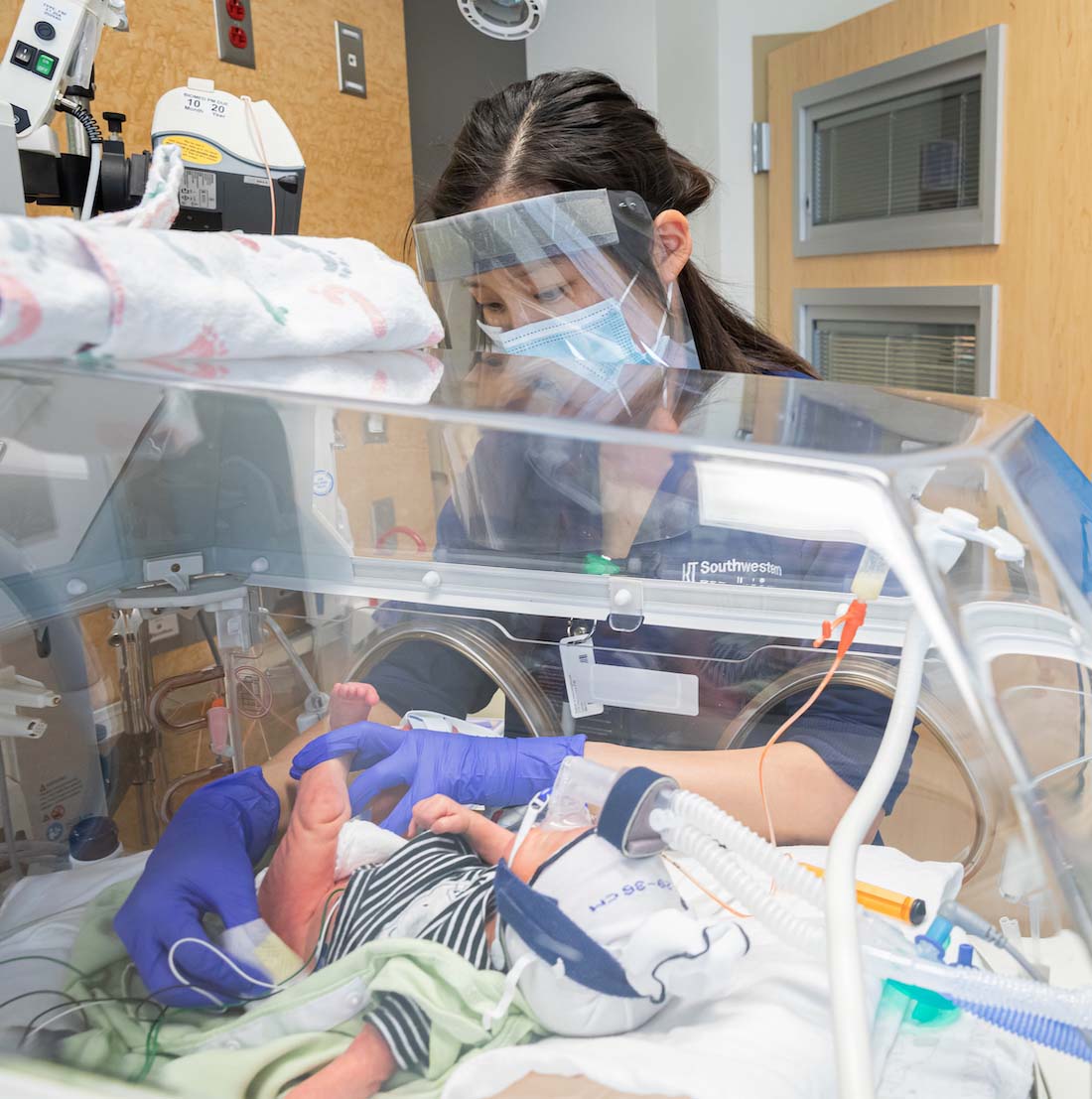QI study demonstrates better outcomes for NICU infants with optimized use of CPAP and surfactant
UTSW neonatologists define improved strategies in AAP journal Pediatrics

DALLAS – Oct. 15, 2021 – A study conducted at Parkland Health and Hospital System by neonatologists from UT Southwestern Medical Center showed that optimizing the use of continuous positive airway pressure, or CPAP – the same method used to treat patients with sleep apnea – decreased the need for mechanical ventilation in premature infants when used with less invasive surfactant administration (LISA).
Mechanical ventilation can damage the developing lungs of preterm infants, and avoiding intubation decreases death or bronchopulmonary dysplasia, a chronic lung disease that prolongs hospitalization.
“Infants are increasingly being admitted to the neonatal intensive care unit, or NICU, from the delivery room on CPAP, but 40 to 50% of those infants fail CPAP and end up requiring mechanical ventilation during the first 3 days of life. We began looking for ways to decrease CPAP failure in premature infants 29 weeks or younger gestational age and were able to identify a number of critical factors,” said lead author Venkatakrishna Kakkilaya, M.D., Associate Professor of Pediatrics in Neonatal-Perinatal Medicine. The neonatologists are part of the UTSW Pediatric Group physicians who provide clinical services through Parkland Hospital, William P. Clements Jr. University Hospital, Southwestern Health Resources-Texas Health Dallas Hospital, and Children’s Health.
In Pediatrics, the journal of the American Academy of Pediatrics, the consortium of neonatologists, nurses, advanced practice providers, and respiratory therapists that conducted the study outline a bundle of quality improvement initiatives for premature infants admitted to the NICU. By carefully escalating CPAP, using LISA, and following strict guidelines for intubation when these measures fail, they were able to decrease CPAP failure and other complications, including pneumothorax and patent ductus arteriosus, a heart problem commonly seen in premature infants. As a result, fewer infants needed mechanical ventilation during the hospital stay.
“The bundle that we created, which we call OPTISURF, is now an integral part of the culture of the NICU. This was critical to our success and is important for others who want to adopt this approach,” said senior author Mambarambath Jaleel, M.D., Associate Professor of Pediatrics at UT Southwestern in Neonatal-Perinatal Medicine.
Comparing the use of OPTISURF to the outcomes prior to its adoption, the researchers reported:
- a higher proportion of infants received CPAP within 4 hours of life (7% vs. 32%)
- lower rates of CPAP failure (54% vs. 11%)
- lower rates of pneumothoraces (8% vs. 1%)
- less need for mechanical ventilation (58% vs. 31%)
- less patent ductus arteriosus treatment (21% vs. 9%)
The most dramatic reduction in CPAP failure was among infants in the 23 to 26 weeks gestational age range – 79% vs. 27% – but a significant improvement was also noted in the 27 to 29 weeks gestational age range – 46% vs. 3%.
In addition, the study demonstrated the safety of the use of a thin catheter for LISA, thereby avoiding intubation. The team also developed a readily available video and used simulation-based training, which played a key role in training physicians to use the new procedures.
“This important study should stimulate the wider use of these strategies in the neonatal community, and we now need larger studies in various delivery room and neonatal intensive care settings for this bundle,” said Rashmin C. Savani, M.D., Chief of the Division of Neonatal-Perinatal Medicine, who holds The William Buchanan Chair in Pediatrics.
Other authors include Heather Weydig, M.D.; William Smithhart, M.D.; Shelly Renfro, RRT; Kristi Garcia, RRT; Cari Brown, RNC-NIC; Henry He, M.D.; Sheron Wagner, D.N.P.; Glenn C. Metoyer, RRT; L. Steven Brown, M.S., CPH; and Vishal S. Kapadia, M.D. Dr. Kapadia is supported by a K23HD083511 grant by the National Institutes of Health.
About UT Southwestern Medical Center
UT Southwestern, one of the nation’s premier academic medical centers, integrates pioneering biomedical research with exceptional clinical care and education. The institution’s faculty has received six Nobel Prizes and includes 25 members of the National Academy of Sciences, 16 members of the National Academy of Medicine, and 14 Howard Hughes Medical Institute Investigators. The full-time faculty of more than 2,800 is responsible for groundbreaking medical advances and is committed to translating science-driven research quickly to new clinical treatments. UT Southwestern physicians provide care in about 80 specialties to more than 117,000 hospitalized patients, more than 360,000 emergency room cases, and oversee nearly 3 million outpatient visits a year.
